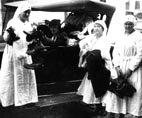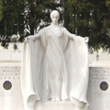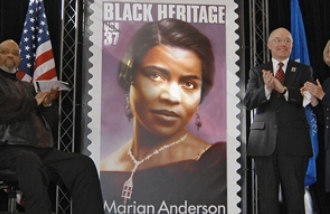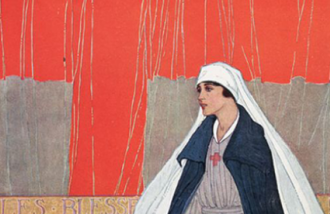Two decorated U.S. Army veterans—one in the Women’s Army Auxiliary Corps and the other in the U.S. Army Nurse Corps—exemplify the meaning of service through their valorous efforts in the European theater of World War II.
By Lena Anthony
Photos courtesy of Helen Evans
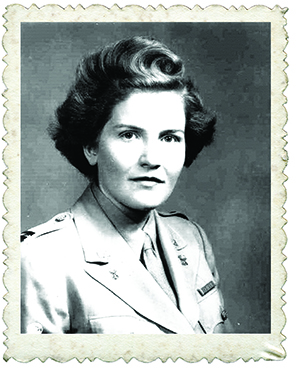
It was 1942, and Helen Horlacher Evans was a newly minted home economics teacher when she heard the news. Congress had just passed a bill authorizing women to serve in the military, which had previously been open only to women who were nurses.
She was instantly intrigued. She had seen male friends and former classmates called up for service since the attack on Pearl Harbor, and her patriotic upbringing fueled her interest. But it was an innocent dare, waged among three young teachers in a Versailles, Ky., high school, that got the application in her hands. All three friends filled one out, but only Mrs. Evans was accepted as an officer candidate in the Women’s Army Auxiliary Corps (WAAC). (The WAAC was formed in 1942, and then became the Women’s Army Corps [WAC] on July 1, 1943.)
Although nearly 80 years have passed, Mrs. Evans can still recall, in vivid detail, her mother’s reaction when she told her she had applied. “She jumped up from the dining room table, shouting, ‘You’ll be killed!’” said Mrs. Evans, who is a member of Captain John Waller DAR Chapter, Lexington, Ky. “My mother had every reason to be upset, because she already had friends here in Lexington who had lost a son.”
Her service started in August 1942. At 21, she was among the youngest of the women in her officer training class and one of the first women to serve in the Army outside of nursing during World War II. As a home economics college graduate, she was placed in food service and trained at an Army-operated school for bakers and cooks in Fort Riley, Kan., and Fort Meade, Md. But Mrs. Evans never cooked for the military. Instead, her job was to travel the country, training other WACs on mess hall operations. She was later transferred to the Office of the Quartermaster General and put in charge of inspecting WAC mess halls. In 1944, she was responsible for a survey that determined the dietary needs of a WAC strength of 100,000, which resulted in $2 million annual savings.
It wasn’t until early 1945 that Mrs. Evans was transferred to the Office of the Quartermaster General in Europe, which was headquartered in Paris, France. Her lodging was Room 413 in a hotel, which is now the 5-star Hotel Balzac. (Mrs. Evans has returned twice to Paris to see her old living quarters.) While the hotel was only for WACs, Mrs. Evans did not work with other WACs. She worked with a male officer, carrying out inspection duties, much like she did stateside.
By the time the war ended, Mrs. Evans was stationed in Germany along the Rhine River, helping take care of German women prisoners of war. She even helped care for an infant who was born to one of the women there. After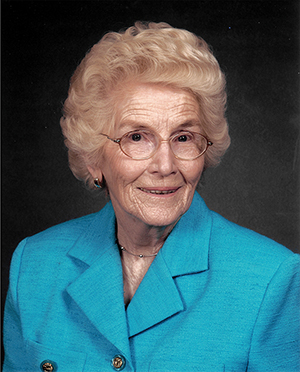 the Germans surrendered, Mrs. Evans was transferred to Camp Lucky Strike, an embarkation camp on the French coast, where she stayed for a few weeks before returning home to Kentucky.
the Germans surrendered, Mrs. Evans was transferred to Camp Lucky Strike, an embarkation camp on the French coast, where she stayed for a few weeks before returning home to Kentucky.
“When I got home, I felt lost,” she said. “I can definitely relate to that feeling that our servicemen and women have today after they return home. You get accustomed to the security available through the military, and you suddenly come back and you’re in a totally different realm.”
She soon landed a job at the Department of Veterans Affairs, helping Kentucky veterans take advantage of the newly established G.I. Bill. She married her husband, Joe, also a World War II veteran, in 1948. He had wanted to get married earlier, but Mrs. Evans insisted he finish his degree at the University of Kentucky first.
“He graduated on a Friday night, and we married Saturday at 10 a.m.,” she said.
Their first child, Carson, was born in 1951, marking the end of Mrs. Evans’ professional career and the beginning of her volunteer one. Their daughter, Beth, was born two years later.
From the DAR, which she joined in 1948, to the Kentucky Federation of Women’s Clubs, where she served as president in the 1970s, to the local VA hospital, Mrs. Evans has been a faithful volunteer for a variety of causes over the years.
And for her service both to her country and her community, she has received numerous awards, including being inducted into the United States Army Quartermaster Corps Hall of Fame, the Lexington/Fayette County Senior Citizen Hall of Fame and the Kentucky Veterans Hall of Fame.
She also speaks frequently about her experience in World War II to groups both young and old.
“I enjoy speaking about it,” she said. “I feel like what we did then has significance to what people do now. The past has a lot of relevance and importance in our lives today.”
Caregiver for the Frontlines
By Mary S. Elcano
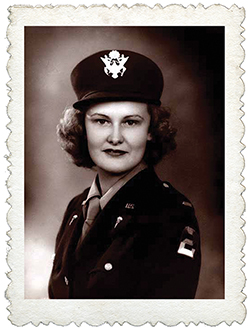 In 1943, Marian Rebecca Sebring Elcano embarked on a remarkable wartime odyssey that began in Oil City, Pa., and ended after two years of service as an Army nurse in the European theater of World War II. Mrs. Elcano cared for thousands of patients, spanning the Normandy invasion, battles in Northern France, and engagements in Belgium and Germany. She was witness to the Battle of the Bulge and the Battle of Remagen Bridge to the liberation of Buchenwald Concentration Camp and the Allied victory in Germany.
In 1943, Marian Rebecca Sebring Elcano embarked on a remarkable wartime odyssey that began in Oil City, Pa., and ended after two years of service as an Army nurse in the European theater of World War II. Mrs. Elcano cared for thousands of patients, spanning the Normandy invasion, battles in Northern France, and engagements in Belgium and Germany. She was witness to the Battle of the Bulge and the Battle of Remagen Bridge to the liberation of Buchenwald Concentration Camp and the Allied victory in Germany.
“It was absolutely the right thing for me to do at that time,” Mrs. Elcano said of her decision to serve. “I don’t think I could have done anything else, because the war in Europe was going on and we all wanted to get in there and help.”
*Prepping for Service
After graduating from nursing school at age 20, Mrs. Elcano enlisted in the U.S. Army Nurse Corps. Her first stop in January 1943 was Camp Gordon in Augusta, Ga., where she joined the 45th Evacuation Hospital and prepared for deployment.
The 45th left New York in a convoy bound for England on November 17, 1943. After their troopship Aquitania landed in Greenock, Scotland, the 45th immediately boarded trains bound for Wotton-under-Edge in Gloucestershire, England. From November 1943 until June 1944, the nurses were billeted among the local population, with Mrs. Elcano staying with a baker’s family. Seven days after the D-Day invasion, on June 13, 1944, the 45th left for France.
*D-Day + 10
At 3 p.m. on June 16, 1944, the 45th crossed the English Channel aboard HMS Glenearn. “We landed at Omaha Beach, but couldn’t get close to the shore because of the tide,” Mrs. Elcano recounted. “We had to wade from the landing craft with our Army gear and equipment strapped on.”
The 45th was the second evacuation hospital into Europe after the D-Day invasion. The first one was established on the bluff above Omaha Beach. The 45th moved up the bluff to assist the other hospital unit, which had been working 24-hour days.
Considerable air activity occurred over the Omaha Beach sector from both the Allied and German planes. “We had huge red crosses on the ground by our tents and on the roof of the tents,” Mrs. Elcano recounted. “We hoped they were going to honor the Red Cross Geneva Convention. And they did.”
In the summer of 1944, the front line started moving quickly across Northern France. As the front moved, so did the evacuation hospitals. The 45th traveled hundreds of miles across Northern France, working long shifts under difficult circumstances. In addition to treating many
serious battle casualties, including chest, abdominal and head injuries, the 45th cared for victims of malaria, respiratory infections and pernicious anemia.
“It wasn’t like the movies,” Mrs. Elcano observed. “We didn’t have time to get to know the patients well. We weren’t their girlfriends. When you are so busy, you have to keep going from one to the other, and you don’t have much time to think.”
*Battles of the Bulge and Remagen Bridge
As the Allied Forces moved into Belgium in September 1944, the 45th followed closely behind, using deserted school buildings and abandoned hotels as hospitals. From December 16, 1944, to January 25, 1945, the German Army launched the massive offensive known as the Battle of the Bulge. During the most intense fighting, the 45th hospital was close to the front in a school building in Eupen, Belgium. 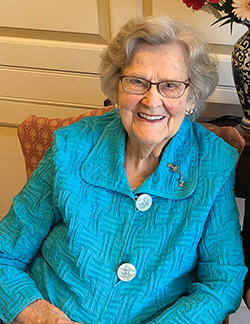
During one attack, patients were quickly moved to the school basement where shelters and an emergency surgery facility were set up. Mrs. Elcano and the other 45th nurses crawled on the floor, dispensing medication to the injured.
The high-pitched, shrieking sounds of combat—particularly the bombs nicknamed “Screaming Meemies”—were among her most terrifying memories of the war. Mrs. Elcano described the noise as “absolutely petrifying. … The bomb would just scream like a person for three minutes.”
Due to the repeated threat from enemy aircraft, all patients were evacuated, and the hospital was dismantled. The hospital staff moved to Malmedy, Belgium, where Christmas was celebrated among the sounds of intermittent bombing and strafing.
In March 1945, the German Army retreated into the Rhineland to bomb the Remagen Bridge and prevent the Allied forces from crossing the Rhine. Several battles took place at the bridge, and as the closest evacuation hospital, the 45th treated many casualties.
After the Remagen Bridge collapsed on March 17, 1945, within a few days Army engineers built new metal and pontoon bridges for the Allied forces to cross the Rhine River into Germany. Following closely behind the front lines, the 45th was the first American evacuation hospital in Germany.
*Victory in Europe
The 45th remained in Germany until June 1945. During that time, evacuation hospitals transitioned to serve both combat forces and noncombatants, such as survivors from concentration camps. In April 1945, when the 6th Armored Division liberated the Buchenwald Concentration Camp, doctors from the 45th accompanied them and set up an evacuation hospital in renovated buildings previously used as the Waffen-SS barracks. Once the survivors were evacuated, nurses of the 45th visited the camp and witnessed firsthand the inhumanity of Nazi Germany.
After the evacuation of Buchenwald, the 45th headed across Germany, almost reaching Berlin by the time the war ended. “You could always tell when the battles were over because the number of wounded decreased,” Mrs. Elcano said.
On November 20, 1945, in Le Havre, France, the nurses of the 45th boarded the Thomas H. Barry for America. Mrs. Elcano was discharged as a captain in the U.S. Army at Fort Dix, N.J., and returned home. The 45th Evacuation Hospital was awarded five Campaign and Service Medals and the Meritorious Service Unit Plaque for their extraordinary medical service in World War II.
For more Today’s Daughters, please click here.
To nominate a Daughter for a future issue, e-mail a description to [email protected].


